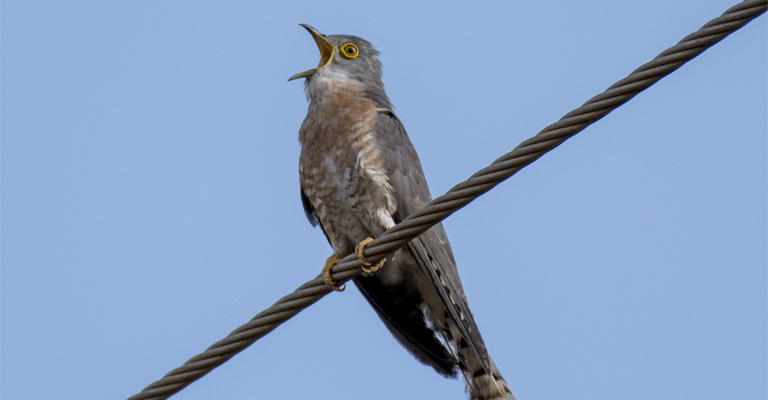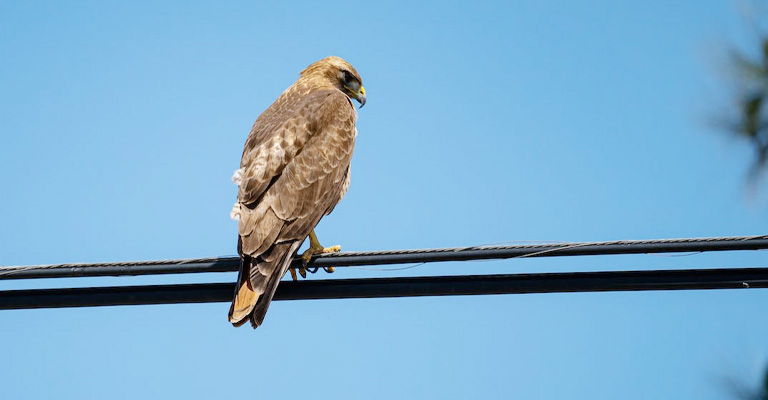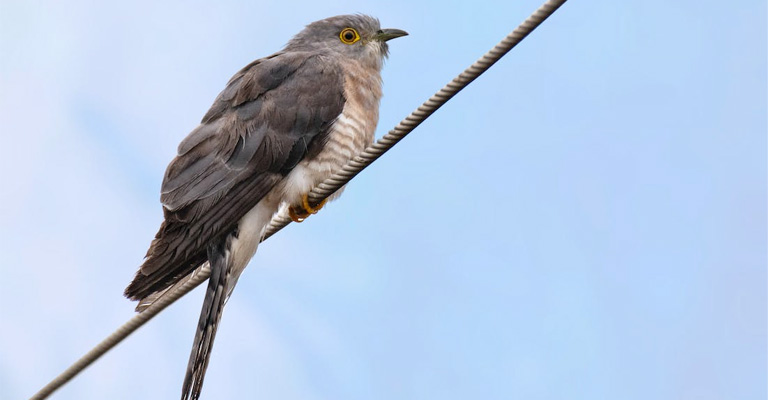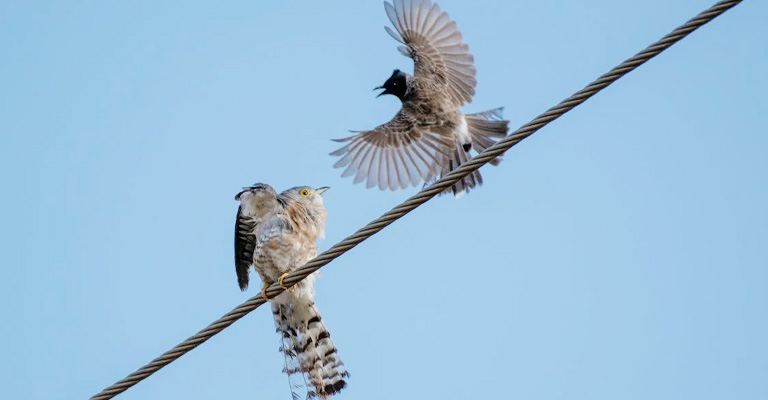Birds sitting on power lines are a common sight that raises curiosity among observers. This behavior may seem puzzling at first, but there are several reasons why birds perch on power lines.
As we know, power lines provide an unobstructed view and an open space for takeoff, making them ideal perches for birds to rest and groom their feathers.
While power lines may carry electricity, birds have an inherent ability to avoid electric shock due to their unique physiology.
In this blog, we will discuss facts on why birds sit on the power lines in the context of their behavior. So, if you have this question in your mind and want to know this as a curious person, please read the entire article.

Why do Birds think Sitting on Power Lines Is Safe?
Birds actually aren’t aware of the electricity fact of the power lines. There are a few reasons they find the line safe for sitting. Here, they think about the following benefits.
Safety From Ground Predators
Power lines offer birds a respite from ground-dwelling predators such as cats, coyotes, and other potential threats.
By perching on elevated power lines, birds can effectively avoid the reach of these predators, ensuring their safety while resting or engaging in other activities.
The height of power lines provides a natural barrier that offers birds a sense of security.
Elevated Vantage Point for Hunting

One of the advantages of power lines for birds, particularly raptors and birds of prey, is the elevated vantage point they provide. From their perch on power lines, these birds have a wide and unobstructed view of the surrounding area.
This advantageous position enables them to spot potential prey on the ground below, such as rodents, insects, or small mammals.
With their sharp vision and keen hunting skills, birds like hawks and shrikes can take advantage of this advantageous position to successfully locate and capture their prey.
Resting and Roosting Opportunities
Power lines also serve as convenient resting spots for birds during their daily activities. Birds often use power lines as temporary resting places between flights or during breaks from foraging.
The horizontal alignment and stability of power lines make them suitable for birds to perch and rest. Additionally, power lines can serve as communal roosting sites, where multiple birds gather and settle for the night.
These roosting aggregations provide social interaction, warmth, and protection in numbers for the birds.
Understanding Bird Behavior on Power Lines

There are some interesting facts regarding birds’ nature to sit on the power line. If we think it in the context of their behavior, it will definitely surprise you.
Orientation: Facing the Same Direction
Comparison to Airplanes and Wind Direction
Similar to airplanes taking off and landing in the wind for aerodynamic reasons, birds on power lines align themselves in a specific direction.
This behavior helps them optimize their flight performance and take advantage of the prevailing wind conditions.
By facing into the wind, birds can experience reduced air resistance during takeoff, making it easier for them to launch into flight when needed.
The Aerodynamic Advantage for Quick Takeoff
Facing the same direction also provides birds with a tactical advantage in terms of quick takeoff.
In the event of potential danger or threat, birds are poised to make a swift escape by taking off in the direction they are already facing.
This orientation minimizes the time and effort required for birds to respond and flee, enhancing their chances of evading predators or other hazards.
Adaptability to Inconsistent Wind Directions

Optimizing Visibility of Surroundings
Birds on power lines are highly adaptable to changing wind directions. While they may exhibit a consistent orientation, individual birds often adjust their positions on the power line to optimize their visibility of the surrounding environment.
By strategically positioning themselves, birds can have an unobstructed view of potential prey, predators, or other important elements in their surroundings.
This behavior allows them to remain vigilant and respond swiftly to any changes or opportunities.
Balancing Wind Exposure and Stability
Birds perched on power lines must also consider their stability in relation to varying wind conditions.
They adjust their positions to find a balance between exposure to the wind, which can affect their balance and perch stability, and maintaining a suitable vantage point.
This ability to adapt to changing wind directions enables birds to remain perched comfortably while keeping an eye on their surroundings.
Potential Risks for Birds on Power Lines
Whenever you see some birds sitting on the power line, you must be thinking about the potential risk of getting attacked by the electricity, right?
But do you know that there are some other types of risk besides electric shocks? Here is the potential risk for the birds that sit on the power line.
Collisions and Electrocution Incidents
Impact on Bird Populations
Collisions with power lines can result in injury or death for birds. The high number of power lines and their extensive distribution across landscapes increase the likelihood of such incidents.
These collisions can have significant consequences for bird populations, contributing to injuries, fatalities, and potential declines in certain species.
Efforts to Mitigate Risks and Protect Birds
Various initiatives have been undertaken to reduce the risk of collisions and electrocution for birds on power lines.
One approach involves modifying power line structures to make them more visible to birds, such as using bird markers or deterrent devices that improve visibility and reduce the likelihood of collisions.
Additionally, insulated covers or specialized designs for power line equipment help mitigate the risk of electrocution.
Variations in Risks for Different Bird Species and Sizes
The risks associated with power lines can vary among different bird species and sizes due to factors such as wing span, behavior, and habitat preferences.
Larger bird species may face a higher risk of electrocution as their size increases the likelihood of contacting multiple power lines or different phases of electricity.
Additionally, migratory birds that travel long distances may encounter power lines more frequently, increasing their exposure to potential risks.
Efforts to mitigate these risks often involve research and collaboration among conservation organizations, power companies, and governmental agencies.
These initiatives focus on identifying high-risk areas, implementing preventive measures, and raising awareness about the importance of protecting bird populations and their habitats.
Impact of Human Activities on Birds and Power Lines
Now the question is what we can do to save the birds from the risk of getting hurt while sitting on the power line. Well, we have a lot of things to do. Here are some tricks we can follow.
Historical Perspective: Birds Perching on Trees
Before human intervention and landscape modifications, birds primarily perched on trees and natural structures. Trees provided abundant perching options for birds, offering them safety, nesting sites, and opportunities for foraging.
However, as human populations expanded and landscapes were transformed, traditional perching sites for birds were diminished or lost.
Human-altered Landscapes and the Prevalence of Power Lines
As human activities altered landscapes, the construction of power lines became necessary to transmit electricity across vast areas. Power lines often span long distances, cutting through various habitats and ecosystems.
These structures now serve as prominent perching locations for birds due to their ubiquity and visibility in the landscape. The availability of power lines as substitute perches has increased significantly due to human activities.
Conservation Efforts and Finding Solutions
Recognizing the challenges and risks associated with bird interactions with power lines, conservation efforts have been initiated to minimize negative impacts and find solutions.
These efforts include:
- Avian-friendly infrastructure design: Engineers and conservationists collaborate to develop power line structures that are more bird-friendly, incorporating features such as insulated materials, bird diverters, and perch deterrents to reduce collisions and electrocutions.
- Habitat conservation: Protecting and restoring habitats that support bird populations is crucial for their overall well-being. Preserving natural perching sites, including trees, and creating suitable habitats near power line corridors can offer alternative options for birds.
- Research and monitoring: Scientific studies help understand bird behaviors and the effectiveness of mitigation measures. Research provides valuable insights for implementing evidence-based conservation strategies and continuously improving solutions.
- Public awareness and education: Raising awareness among the general public, power companies, and policymakers about the impacts of power lines on bird populations fosters support for conservation efforts.
Education programs and campaigns promote responsible infrastructure development and encourage bird-friendly practices.
The collaboration between conservation organizations, power companies, and policymakers plays a vital role in finding sustainable solutions that balance the need for electricity transmission with the protection of bird populations.
By considering the historical perspective, recognizing the consequences of human-altered landscapes, and actively engaging in conservation efforts, we can mitigate the impacts of power lines on birds and work towards a harmonious coexistence between human infrastructure and avian species.
FAQs
Power lines can disrupt bird migration patterns by creating physical barriers or obstacles in their flight paths. Birds may collide with power lines during migration, leading to injuries or fatalities.
Conservation efforts aim to identify high-risk areas and implement measures to reduce the impact on migrating birds.
Power lines can interfere with bird communication and mating behaviors. Some bird species rely on vocalizations and visual displays to attract mates and establish territories.
The electromagnetic fields generated by power lines may disrupt these signals, potentially impacting their breeding success and population dynamics.
Certain bird species, such as large raptors or waterfowl, may be more susceptible to collisions with power lines due to their size, flight behavior, or habitat preferences.
Additionally, migratory birds that pass through power line corridors are at a higher risk. Conservation efforts focus on understanding these species-specific risks and implementing targeted mitigation strategies.
Collisions and electrocutions on power lines can have significant impacts on bird populations. These incidents can lead to injuries, fatalities, and reduced reproductive success.
Over time, the cumulative effects can result in population declines, particularly for vulnerable or threatened species.
Many countries have regulations and guidelines in place to mitigate the impacts of power lines on birds. These may include requirements for avian-friendly infrastructure design, installation of bird diverters or markers, and adherence to environmental impact assessments during power line construction or maintenance projects.
Wrapping Up
The act of birds sitting on power lines is not as mysterious as it may initially appear. Birds utilize power lines for practical reasons such as obtaining a clear view of their surroundings, searching for food, and finding suitable nesting sites.
Despite the presence of electricity, birds have adapted mechanisms that prevent them from receiving electric shocks.
By understanding these factors, we can appreciate the resourcefulness of birds in utilizing man-made structures for their benefit.
Next time you see a bird perched on a power line, you can marvel at its ability to adapt and make use of its environment to meet its needs. Thank you in advance.